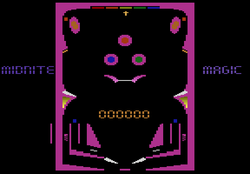- Midnight Magic (Atari 2600)
-
This article is about the Atari 2600 game. For the Brøderbund Software game, see David's Midnight Magic.
Midnight Magic 
Atari's Midnight Magic for the Atari 2600 brought realistic pinball simulation to home video game consoles.Developer(s) Atari Publisher(s) Atari Distributor(s) Atari Designer(s) Glenn Axworthy Platform(s) Atari 2600 Release date(s) 1987
(Copyright 1984)Genre(s) Pinball Mode(s) Single player Rating(s) Pre-ESRB Media/distribution Cartridge System requirements Atari 2600 console
and controlsMidnight Magic is a video game released for the Atari 2600 video game console in 1987, although on-screen it displays a copyright of 1984. The delay is most likely due to the video game crash of 1983. As Atari's second attempt at a video game simulation of pinball, Midnight Magic features more realistic ball physics and graphics than the older Video Pinball.[1] The game was programmed by Glenn Axworthy.[2] In spite of its similar name, the Atari version of Midnight Magic uses a completely different table design than David's Midnight Magic, a pioneering pinball simulation for early 1980s home computers.
Midnight Magic features actual simulations of a pinball machine ball shooter, flippers, bumpers, and spinners, as well as improved simulation of the ball's actual physics. Midnight Magic was also the first home video game pinball simulation to feature four flippers instead of two (two sets of two).[citation needed]
Gameplay
Midnight Magic utilized the Atari 2600 joystick for performing simulated pinball functions, such as activating the flippers and shooting the ball. Moving the joystick controller down pulls the pinball machine plunger back while pressing the joystick button shoots the ball into the playfield. The left and right flippers are activated by moving the joystick controller left or right. Hitting all five drop targets at the top of the table increases the bonus multiplier (2x, 3x, and so on). Extra balls can be earned when hitting the rollover targets at the top left and right corners of the table when the bonus multiplier is activated.[3]
References
External links
- Midnight Magic at AtariAge
- Midnight Magic at MobyGames

This article about a video game released on an Atari console is a stub. You can help Wikipedia by expanding it.
